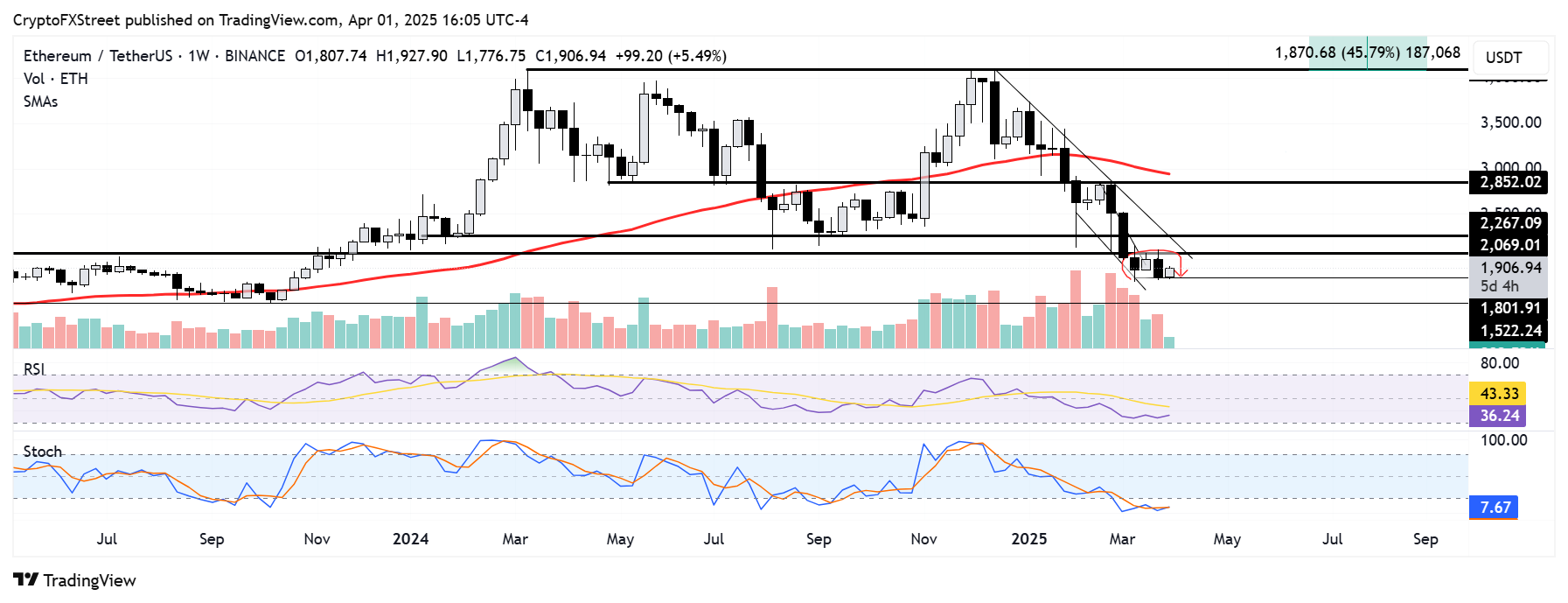Current Ethereum Price: $1,910
- In March, Ethereum surpassed Solana in DEX trading volume due to a drop in memecoin trading.
- An executive from Derive believes that the upcoming Pectra upgrade may catalyze a potential recovery for ETH by the end of Q2.
- ETH was unable to confirm a rounding top pattern after bouncing from the $1,800 support zone.
On Tuesday, Ethereum (ETH) rose by 5%, starting the second quarter on a hopeful note after a challenging Q1. Following its recent rise in decentralized exchange (DEX) trading volume and the anticipated Pectra mainnet upgrade, the leading altcoin might see a rebound in Q2.
Ethereum’s Potential Growth in Q2
In March, Ethereum led in DEX trading volume among major blockchains, overtaking Solana for the first time since September 2024. Ethereum’s DEXs reported a total volume of $64.69 billion, compared to Solana’s $52.62 billion, as per data from DefiLlama.
Nevertheless, the overall DEX volume remains significantly below levels observed in the previous four months, especially in January when Solana and Ethereum combined saw volumes of $258.49 billion and $86.11 billion, respectively.
DEXs volume by chain. Source: DefiLlama
The significant decline in volume is attributed to a noticeable drop in memecoin activity following tariff announcements from President Donald Trump, which further fueled the downward trend in the crypto market.
Despite leading DEX volume in March, ETH continued its downward trajectory, recording a 21% monthly loss.
Ethereum had its worst first quarter since 2018, suffering a 45% decline, according to Coinglass data. This marks the lowest quarterly performance since the bear market of Q2 2022.
However, with exciting new features expected from the Pectra upgrade, set to launch on April 30, Ethereum has the potential to surpass Solana’s trading volume and possibly bounce back in Q2, historically one of ETH’s strongest quarters.
“Although ETH may face further declines in April, attributed to stagnant daily transactions and ETF inflows, there is optimism for a recovery by the end of Q2 as the Pectra upgrade becomes effective and interests reignite with ETH CC approaching in Cannes,” noted the Head of Research at a crypto options exchange.
“For ETH, there’s a 22% chance the price dips below $1,600 by April 25, and a 17% chance it rises above $2,000 by the same date,” they added, using insights from Derive trading data.
The Pectra upgrade is set to introduce various features to Ethereum, such as wallet recovery, transaction batching, and blob expansion.
Ethereum Price Outlook: ETH Rebounds from $1,800, Fails to Confirm Rounding Top Pattern
Recently, Ethereum experienced $45.80 million in futures liquidations, as per Coinglass data. The total for both long and short liquidations amounted to $9.73 million and $36.07 million, respectively.
ETH rebounded from the $1,800 support level, increasing by 5% on Tuesday after failing to confirm a rounding top formation on the weekly chart. The leading altcoin now encounters a barrier at $2,070, a resistance level that appears to be gaining strength due to two consecutive weeks of rejections at this point.
ETH/USDT weekly chart
If ETH successfully breaks through the resistance levels at $2,070, $2,260, and a descending trendline from December 16, it could initiate a significant upward trend. Conversely, a drop below $1,800 may lead ETH to find support at $1,500.
The Relative Strength Index (RSI) is currently below neutral, while the Stochastic Oscillator (Stoch) has remained in the oversold zone since February, indicating prevailing bearish momentum. Both the RSI and Stoch need to establish a strong cross above their moving averages and neutral levels to support a bullish outlook.
Ethereum FAQs
Ethereum is an open-source, decentralized blockchain that enables smart contracts. Its native currency, Ether (ETH), is the second-largest cryptocurrency and the leading altcoin by market capitalization. The Ethereum network is designed for creating crypto solutions like decentralized finance (DeFi), GameFi, non-fungible tokens (NFTs), decentralized autonomous organizations (DAOs), and more.
Ethereum is a public, decentralized blockchain technology that allows developers to create and deploy applications without the need for a central authority. To facilitate this process, the network uses the Solidity programming language and the Ethereum virtual machine, enabling developers to build and launch applications with smart contract capabilities.
Smart contracts are verifiable codes that automate agreements between parties. They execute encoded actions automatically when specific conditions are met.
Staking allows users to earn rewards on their idle cryptocurrencies by locking them in a protocol for a designated period, contributing to its security. Ethereum transitioned to a Proof-of-Stake (PoS) consensus mechanism from its previous Proof-of-Work (PoW) setup on September 15, 2022, in an event known as “The Merge.” This transition was crucial for Ethereum’s goal of achieving enhanced scalability, decentralization, and security while remaining sustainable. Unlike PoW, which necessitates expensive hardware, PoS lowers the entry barriers for validators by relying on crypto tokens for its consensus process.
Gas refers to the unit used to measure transaction fees that users incur while performing transactions on Ethereum. During busy network times, gas fees can skyrocket, leading validators to prioritize transactions based on their fees.

